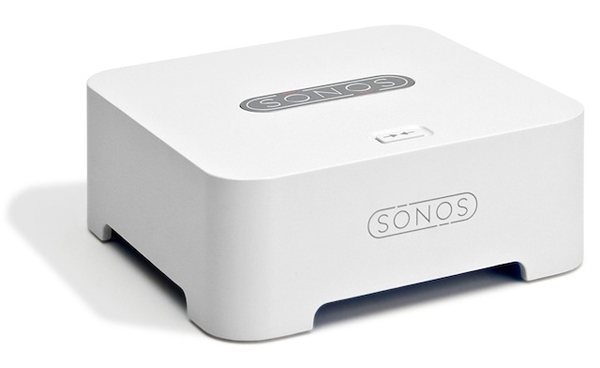Thursday, January 20, 2011
In The Zone - The Sonos ZonePlayer S5 System
Posted by Matthew Shanks in "Digital Home Hardware & Accessories" @ 10:00 AM

Product Category: Wireless Music System
Manufacturer: Sonos
Where to Buy: Amazon [USA, Affiliate], Future Shop [Canada]
Price: $448 USD (Amazon), $480 CAD (Future Shop) - ZonePlayer S5 & ZoneBridge Bundle
System Requirements: Windows PC or Mac with internet and router for home network access
Specifications: White or black, speakers include 2 tweeters, 2-3" mid-range drivers, 1-3.5" woofer, powered by 5 dedicated Class D digital amplifiers.
Pros:
- Extremely simple set-up and operation;
- Impressive audio performance;
- Allows whole house audio distribution with additional ZonePlayers;
- ZonePlayers can be synchronized or play different music in different zones.
Cons:
- More expensive than many iPod docks;
- Desktop Controller Software isn't as polished as it could be and has some issues with iTunes libraries;
- Cannot play protected music songs, unless upgraded through iTunes.
Summary: The ZonePlayer S5 is a standalone wireless audio system that is very simple and intuitive to set-up and operate. Its audio capability is impressive and it performs its purpose extremely well - quickly and easily accessing and controlling your computer's music collection, Internet radio and music services. Using the ZonePlayer is a very different experience than using an iPod dock, and once you have used it, you will never want to go back.
Introduction
Sonos is well known for simple and easy to use wireless audio distribution systems that require separate speakers and a wireless handheld unit or computer software for control. The ZonePlayer S5 and ZoneBridge combine to create a standalone wireless audio system that can be controlled through a variety of devices, including the iPad, iPhone, iPod Touch, Sonos desktop controller software, or the Sonos Controller 200 wireless handheld. The system targets the mainstream audience that is currently using their computers or iPod docks to access and enjoy their music collections.
In The Box
The ZonePlayer S5 and ZoneBridge are available in a bundle, but are packaged separately. The packaging is surprisingly minimal, but offers excellent protection for the units. The ZonePlayer S5 and ZoneBridge are each packaged with simple illustrated set-up instructions, detailed product guide, power cord, flat Ethernet cable, and an installation CD. The ZonePlayer is also packaged with a 3.5mm stereo cable for line-in use of another source.

Figure 1: Front View of ZoneBridge
Set-Up
The ZonePlayer requires a wired or wireless connection to your home network in order to access your computer's music collection. It can be connected by Ethernet cable directly to the home network's router, but this set-up will likely not be used by the majority of Sonos owners, unless they already have dedicated Ethernet runs to the rooms they intend to place ZonePlayers in.
Connecting the ZoneBridge directly to the router creates SonosNet, a dedicated and secure peer-to-peer mesh network, independent from any existing wireless network in the house. This network allows wireless access to and control of all connected ZonePlayers, and uses each ZonePlayer as a repeater to extend the range of the wireless network. This maximizes flexibility of the ZoneBridge placement, as each additional ZonePlayer added to the system does not have to communicate directly with the ZoneBridge. The SonosNet also allows for perfect synchronization of connected ZonePlayers throughout the house, or within the same room.
Set-up of the ZonePlayer and ZoneBridge system was extremely simple, utilizing the illustrated and easy to follow instructions. After connecting the ZoneBridge to my router, placing the ZonePlayer in my living room and powering them both up, I installed the Sonos Desktop Controller software on my computer. The software set-up process was simple, requiring only the connect button on the ZoneBridge be pressed to recognize and add it to the network, and then the Mute and Volume buttons be pressed on the ZonePlayer to add it to the network. The software then walks you through the set-up of the music library by adding the location of your music collection, either on your computer's hard drive or on shared network-attached storage (NAS) devices. Within a few minutes of plugging in the units, they were fully operational and controllable by the Desktop Controller.
During set-up, the software does request that users modify their computer sleep settings to prevent the computer from going to sleep and losing connection to the ZonePlayer system. I did not change my sleep settings, as I didn't feel it was much of an inconvenience to wake the computer from sleep to use the system, and I would rather have my computer sleeping at night to conserve power. If possible, it would be a nice future option in the Desktop Controller software to allow requests from the iPod Controller App to bring the computer out of sleep. Internet radio stations are still accessible though when the computer is sleeping.
While the system can be controlled with the Desktop Controller, adding a handheld controller to the system is the final step to allow full wireless control of the ZonePlayer. Sonos has recognized that many of its customers will be upgrading to the ZonePlayer system from iPod docks, and will likely already have a compatible iPod Touch, iPhone or iPad. As such, they offer the free Sonos Controller App through Apple's App Store, available through iTunes or directly on the device. Downloading the application to the device allows complete control over all ZonePlayers connected to the network. It is important to note that wireless control of the system by iPod requires a wireless router in the house for the iPod to connect to.
Sonos also offers their legacy wireless Controller 200, but at a higher price than a fourth generation 16GB or 32GB iPod Touch. With the prevalence of Apple's devices in many homes and the free controller application that offers the same functionality, this controller offers no real value over iPod control aside from dedicated Mute, Volume and Zone buttons.












